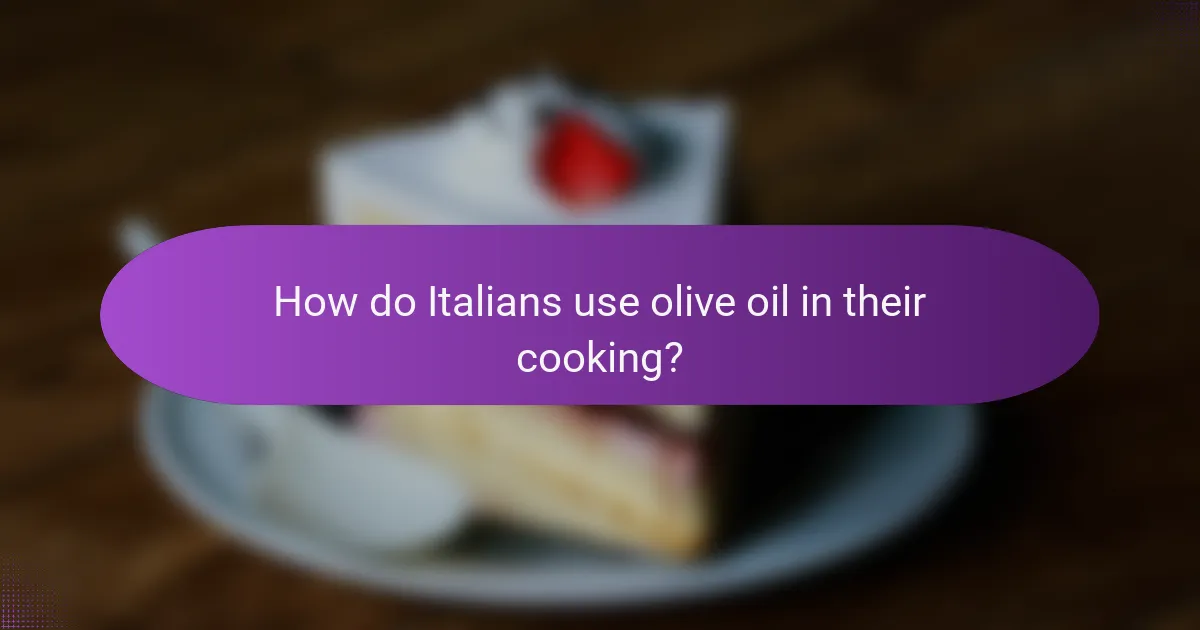
What is the role of olive oil in Italian cooking?
Olive oil is a fundamental ingredient in Italian cooking. It serves as a primary source of fat in numerous dishes. Olive oil enhances flavor and provides richness to recipes. It is used for sautéing, roasting, and dressing salads. Extra virgin olive oil is often drizzled over finished dishes. This oil is prized for its health benefits, including antioxidants and healthy fats. The Mediterranean diet, which emphasizes olive oil, is linked to various health advantages. Historical records show that olive oil has been used in Italy for thousands of years.
How is olive oil integral to Italian culinary traditions?
Olive oil is integral to Italian culinary traditions as a fundamental ingredient in various dishes. It serves as a primary fat for cooking, enhancing flavor and texture. Italian cuisine often features olive oil in dressings, marinades, and sauces. For example, it is essential in making classic dishes like bruschetta and pasta sauces. Olive oil also plays a key role in regional specialties, such as Tuscan bread drizzled with oil. Historically, Italy has cultivated olives for thousands of years, making it a cornerstone of their food culture. The Mediterranean diet, which emphasizes olive oil, is recognized for its health benefits. Studies show that olive oil consumption is linked to lower rates of heart disease.
What historical influences shaped the use of olive oil in Italy?
The use of olive oil in Italy has been shaped by various historical influences. Ancient Greeks and Romans cultivated olives extensively, establishing the foundation for olive oil production. The Mediterranean climate in Italy is ideal for olive growth, promoting its agricultural significance. During the Middle Ages, monasteries played a key role in preserving olive cultivation techniques. The Renaissance further popularized olive oil, linking it to culinary and medicinal practices. Trade routes expanded in the 19th century, increasing olive oil’s availability across Europe. Today, Italian olive oil is recognized for its quality and variety, reflecting centuries of cultural and agricultural evolution.
How does olive oil reflect regional diversity in Italian cuisine?
Olive oil reflects regional diversity in Italian cuisine through its distinct flavors and production methods. Each region in Italy has its own olive varieties, impacting taste and aroma. For example, Tuscany is known for its robust, peppery oils, while Liguria produces milder, fruity oils. The terroir, including soil and climate, influences the characteristics of the olives. Different regions also have unique culinary traditions that dictate how olive oil is used. In Southern Italy, olive oil is often used generously in dishes like pasta and seafood. In contrast, Northern Italy may use olive oil more sparingly, focusing on butter and cream. The variety of olive oils available showcases Italy’s rich agricultural heritage. This diversity is celebrated in regional festivals dedicated to olive oil, highlighting local producers and their unique offerings.
What types of olive oil are commonly used in Italian cooking?
Extra virgin olive oil, pure olive oil, and light olive oil are commonly used in Italian cooking. Extra virgin olive oil is the highest quality and most flavorful type. It is made from cold-pressed olives and retains the most nutrients. Pure olive oil is a blend of refined olive oil and a small amount of extra virgin olive oil. It has a lighter flavor and is suitable for cooking at higher temperatures. Light olive oil is also a refined oil with a mild taste. It is often used for frying and baking. These oils enhance the flavors of traditional Italian dishes. They are integral to dressings, marinades, and finishing touches on meals.
What are the differences between extra virgin, virgin, and refined olive oil?
Extra virgin olive oil is the highest quality, made from cold-pressed olives. It has a low acidity level, typically below 0.8%. This type retains the most flavor and nutrients. Virgin olive oil is also made from cold-pressed olives but has a slightly higher acidity, up to 2%. It offers good flavor but is less robust than extra virgin. Refined olive oil undergoes processing to remove impurities and acidity. This results in a lighter flavor and higher smoke point. Refined olive oil lacks the strong taste and antioxidants found in the other two types.
How do the types of olive oil affect flavor and cooking techniques?
Different types of olive oil significantly affect flavor and cooking techniques. Extra virgin olive oil has a robust flavor and is best for dressings and drizzling. It retains antioxidants and has a low smoke point, making it unsuitable for high-heat cooking. Virgin olive oil offers a milder taste and can be used for sautéing. Pure olive oil has a higher smoke point and is ideal for frying. Light olive oil, despite its name, has a neutral flavor and is often used in baking. The flavor profile of each type influences the overall taste of dishes. For instance, using extra virgin olive oil enhances salads, while light olive oil is better for baked goods.
What health benefits does olive oil provide?
Olive oil provides numerous health benefits. It is rich in monounsaturated fats, which can improve heart health. Studies show that it lowers bad cholesterol levels. Olive oil also contains antioxidants, which protect against cell damage. Its anti-inflammatory properties can reduce the risk of chronic diseases. Research indicates that regular consumption may lower the risk of stroke. Additionally, olive oil supports brain health and may reduce the risk of Alzheimer’s disease. The Mediterranean diet, which includes olive oil, is associated with longer life expectancy.
How does olive oil contribute to a healthy diet?
Olive oil contributes to a healthy diet by providing essential fatty acids and antioxidants. It is rich in monounsaturated fats, which can lower bad cholesterol levels. This fat type supports heart health and reduces the risk of cardiovascular diseases. Olive oil also contains polyphenols, which have anti-inflammatory properties. Studies show that diets high in olive oil can reduce the incidence of chronic diseases. For example, the Mediterranean diet, which emphasizes olive oil, is associated with lower mortality rates. Additionally, olive oil aids in nutrient absorption, enhancing the benefits of other foods.
What specific nutrients are found in olive oil that promote health?
Olive oil contains several specific nutrients that promote health. Key components include monounsaturated fats, particularly oleic acid. Oleic acid has been linked to reduced inflammation and improved heart health. Olive oil also contains antioxidants, such as vitamin E and polyphenols. These antioxidants help combat oxidative stress and may lower the risk of chronic diseases. Additionally, olive oil is rich in phytosterols, which can help lower cholesterol levels. The Mediterranean diet, which emphasizes olive oil, has been associated with numerous health benefits, including reduced cardiovascular risk.

How do Italians use olive oil in their cooking?
Italians use olive oil as a fundamental ingredient in their cooking. It serves multiple purposes, including sautéing, dressing, and drizzling. Olive oil is often used to enhance the flavor of vegetables and meats. Italians incorporate it into sauces, such as pesto and marinara. It is also a key component in salads, providing richness and depth. Many Italians drizzle olive oil over finished dishes for added taste. The oil is commonly used in traditional recipes, reflecting regional variations. Extra virgin olive oil is preferred for its quality and health benefits.
What are the common culinary uses of olive oil in Italian dishes?
Olive oil is commonly used in Italian dishes for various culinary purposes. It serves as a base for salad dressings, enhancing flavors with its rich taste. Olive oil is also used for sautéing vegetables, providing a healthy cooking medium. In pasta dishes, it is often drizzled over to add depth and richness. Additionally, olive oil is a key ingredient in marinades, infusing meats and vegetables with flavor. It plays a significant role in finishing dishes, adding a final touch of flavor and aroma. Furthermore, olive oil is used in baking, contributing moisture and flavor to bread and focaccia. Its versatility makes it essential in traditional Italian cuisine.
How is olive oil used in dressings and marinades?
Olive oil is commonly used as a primary ingredient in dressings and marinades. It serves as a base for vinaigrettes, providing flavor and richness. Typically, olive oil is combined with vinegar or citrus juice to create a balanced dressing. The oil helps to emulsify the mixture, ensuring even distribution of flavors. In marinades, olive oil acts as a tenderizer for meats and vegetables. It helps to infuse flavors from herbs and spices into the ingredients. Studies show that olive oil enhances the absorption of fat-soluble vitamins from vegetables. Overall, olive oil is essential for its flavor, texture, and health benefits in dressings and marinades.
What role does olive oil play in cooking methods such as sautéing and roasting?
Olive oil serves as a primary fat in cooking methods like sautéing and roasting. It enhances flavor while providing moisture to ingredients. Olive oil has a high smoke point, making it suitable for high-heat cooking. This quality allows it to retain its nutritional properties during the cooking process. Sautéing with olive oil results in tender vegetables and perfectly cooked proteins. Roasting with olive oil promotes even browning and caramelization of food. Studies show that olive oil contains healthy monounsaturated fats. These fats contribute to heart health and overall well-being.
How do you choose the right olive oil for specific recipes?
To choose the right olive oil for specific recipes, consider the flavor profile and intended use. Extra virgin olive oil has a robust flavor, ideal for dressings and drizzling. Light olive oil offers a milder taste, suitable for baking or frying. The smoke point is crucial; oils with higher smoke points are better for cooking at high temperatures. For sautéing, choose oils with a smoke point above 375°F. For finishing dishes, select oils that complement the recipe’s flavors. Quality matters; look for oils labeled “cold-pressed” for better taste and health benefits. Always check the harvest date for freshness, as olive oil degrades over time.
What factors should you consider when selecting olive oil for cooking?
When selecting olive oil for cooking, consider the oil’s type, quality, and smoke point. Extra virgin olive oil is the highest quality, made from pure, cold-pressed olives. Quality olive oil should have a low acidity level, ideally below 0.8%. The smoke point is crucial; oils with higher smoke points are better for high-heat cooking. Extra virgin olive oil has a smoke point around 375°F (190°C). Look for certifications, such as PDO or PGI, which ensure authenticity and quality. Also, consider the oil’s flavor profile, as it can enhance or complement dishes. Freshness is vital; check the harvest date to ensure optimal flavor and health benefits.
How can you ensure the quality of olive oil when purchasing?
To ensure the quality of olive oil when purchasing, check for certification labels. Look for terms like “extra virgin,” which indicates the highest quality. Examine the harvest date on the label; fresher oil is generally better. Observe the packaging; dark glass bottles protect oil from light. Smell the oil; high-quality olive oil has a fruity aroma. Taste the oil; it should have a balanced flavor with a slight peppery finish. Research the brand’s reputation; reputable brands often maintain high quality. According to the International Olive Council, extra virgin olive oil must meet specific chemical and sensory standards.

What are some tips for incorporating olive oil into your cooking?
Use olive oil as a primary cooking fat for sautéing and frying. It has a high smoke point, making it suitable for various cooking methods. Drizzle olive oil over vegetables before roasting for added flavor. Incorporate it into dressings to enhance salads and marinades. Use olive oil as a finishing touch on dishes for a burst of richness. Substitute olive oil for butter in baking to create a healthier option. Pair olive oil with herbs and spices to create flavorful dips and spreads. Store olive oil in a cool, dark place to maintain its quality and flavor.
How can you enhance your dishes with olive oil?
Drizzling olive oil over dishes enhances flavor and adds richness. It can be used as a finishing touch on salads, grilled vegetables, or pasta. Olive oil’s fruity and peppery notes elevate the overall taste profile. Additionally, it can be infused with herbs or spices for added complexity. Using high-quality extra virgin olive oil maximizes health benefits and flavor. Studies show that olive oil contains antioxidants and healthy fats, which contribute to heart health. Incorporating olive oil in cooking methods, such as sautéing or roasting, can also enhance the dish’s aroma and texture.
What are some best practices for using olive oil in Italian recipes?
Use high-quality extra virgin olive oil for the best flavor in Italian recipes. Extra virgin olive oil retains more antioxidants and healthy fats. Drizzle it over finished dishes for enhanced taste. Use it in salad dressings to complement fresh ingredients. Heat olive oil gently to avoid burning and preserve its flavor. Incorporate it into sauces for added richness. Store olive oil in a cool, dark place to maintain its quality. Finally, pair olive oil with complementary flavors like garlic and herbs for authentic Italian dishes.
How can you store olive oil to maintain its quality?
Store olive oil in a cool, dark place to maintain its quality. Exposure to light and heat can degrade the oil. Use a dark glass or stainless steel container for storage. These materials protect against light exposure. Ensure the container is tightly sealed to prevent oxidation. Oxygen can also spoil olive oil over time. Avoid storing olive oil near the stove or in direct sunlight. Ideal storage temperatures range from 60°F to 75°F. Following these guidelines helps preserve the oil’s flavor and nutritional properties.
Olive oil is a fundamental ingredient in Italian cooking, serving as a primary source of fat that enhances flavor and richness in numerous dishes. The article explores the integral role of olive oil in Italian culinary traditions, its historical influences, and its reflection of regional diversity. It also details the various types of olive oil, including extra virgin, virgin, and refined, along with their distinct flavors and health benefits. Additionally, the article provides insights on how to choose, use, and store olive oil effectively in cooking, emphasizing its nutritional advantages within the Mediterranean diet.


